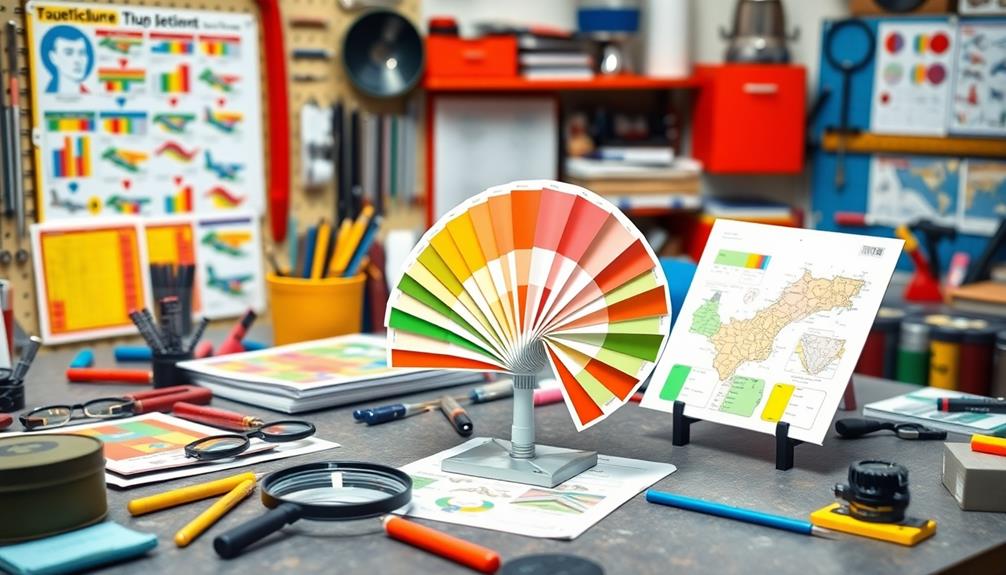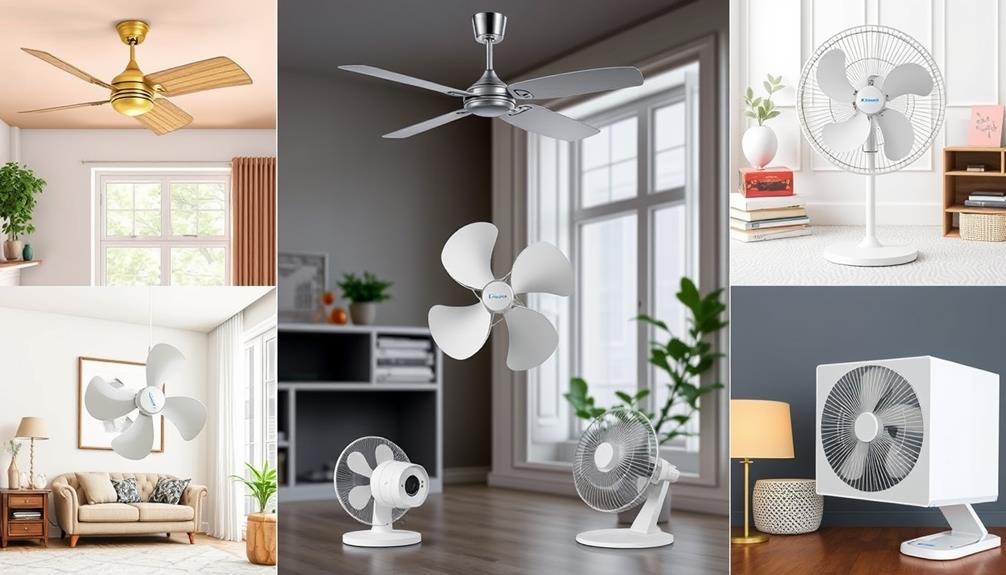To become an expert in handling your fan model quickly, start by examining the fan for serial numbers and model labels. Look at the motor housing for important details such as the manufacturer’s name and voltage ratings. You can also refer to the manufacturer’s website for specific information or seek advice from online forums. Remember to keep track of your findings with labels and organized records for future reference. This straightforward approach will improve your fan’s efficiency, reducing the need for repairs and issues. Stay tuned for additional tips on how to maintain your fan to keep it running smoothly and effectively! Additionally, make sure to regularly clean and lubricate the fan’s moving parts to maintain its peak performance. If you come across a ceiling fan speed stuck problem, it could be caused by dirt buildup or a wiring issue, which can usually be resolved through a thorough inspection and cleaning. By staying proactive with maintenance, you can ensure that your fan operates efficiently and lasts for many years. Furthermore, if your ceiling fan is only running at one speed, it could indicate a faulty capacitor or a problem with the switch itself, both of which are typically easy and affordable to fix. Regularly inspecting these components and conducting routine maintenance can help you identify small issues before they worsen, ensuring that your fan continues to work smoothly. By addressing these problems promptly, you will prolong the life of your fan and experience consistent performance. In addition to regular cleaning and lubrication, keep an eye on any unusual noises that may indicate impending problems, including ceiling fan speed issues. If you notice your fan struggling to reach higher speeds or if it’s making a grinding sound, it’s best to address these concerns before they escalate. By being attentive to your ceiling fan’s performance and addressing any potential ceiling fan speed issues promptly, you’ll not only enhance its longevity but also ensure a comfortable and peaceful environment in your home.
Key Takeaways
- Inspect the fan body for model labels and serial numbers to quickly identify the fan model.
- Check the motor housing for crucial details like the manufacturer's name and voltage ratings.
- Visit the manufacturer's website for specific information and downloadable manuals related to your fan model.
- Utilize online forums and communities for tips and insights from fellow enthusiasts on fan identification.
- Keep organized documentation, including model numbers and maintenance records, for easy reference and future repairs.
Importance of Identifying Fan Model

Often, identifying your fan model is crucial for ensuring ideal performance and maintenance of your equipment. When you know the specific model, you gain access to important information that simplifies upkeep and repairs.
This knowledge allows you to follow the correct procedures and avoid potential mishaps. Additionally, identifying your fan model helps you source compatible replacement parts, preventing damage caused by using the wrong components.
Did you know nearly 40% of users misidentify their fan models? This mistake can lead to ineffective repairs and wasted money.
Methods for Identifying Fan Model

To effectively identify your fan model, you can start by examining both the fan body and its components for essential information.
Look for serial numbers and model labels on the fan body. Inspect the blades for wear, count them, and note their material and any unique markings.
Next, check the motor housing for labels that include the manufacturer's name, voltage, and current ratings. Don't forget to record the date of manufacture, as it can be helpful.
Additionally, visit the manufacturer's website for model-specific information and manuals.
Resources for Model Identification

Once you've gathered the necessary details from your fan's physical components, utilizing various resources can further assist in identifying your specific fan model.
Start by visiting the manufacturer's website; they often provide thorough product information and model lookup tools. If you're unsure, don't hesitate to contact the manufacturer directly, giving them details like the brand and any visible model numbers.
Engaging in online forums can also be beneficial, as fan enthusiasts often share insights and troubleshooting tips.
Finally, consulting with fan repair experts can offer specialized knowledge, helping you decode any markings or logos.
Documentation and Tracking Tips
When it comes to keeping track of your fan models, effective documentation is key to simplifying maintenance and repairs. Start by using label stickers on each fan to note model numbers, warranty information, and troubleshooting tips. This guarantees easy reference and helps with warranty claims.
Additionally, check the fan packaging or manuals for model numbers, which can be vital for registration and future repairs. Organizing your documentation can also help you understand energy savings and comfort associated with your fan models.
Create dedicated folders or binders for manuals, sorting them chronologically or alphabetically. You can also use spreadsheets to record essential details like model numbers, purchase dates, and maintenance histories. This systematic approach will save you time and hassle when it's time for repairs or replacements.
Types of Fans Available

Fans come in various types, each designed to meet specific needs and enhance comfort in different environments.
You've got standard ceiling fans for general air circulation, and low-profile ones perfect for rooms with low ceilings. If you need extra airflow, consider dual-motor ceiling fans, which provide enhanced performance.
For outdoor spaces, outdoor ceiling fans are built to withstand the elements while keeping you cool. Energy-efficient models are great if you want to reduce your energy consumption without sacrificing comfort.
Table and floor fans are also available, offering versatility and easy mobility. Finally, wall-mounted fans save space while delivering effective airflow.
With so many options, you can easily find the right fan to suit your needs.
Benefits of High-Efficiency Filters

High-efficiency air filters are essential for maintaining a healthy indoor environment.
By upgrading to these filters, you'll enjoy several benefits that enhance air quality and system performance:
- Enhanced Filtration: They capture smaller particles, including dust, pollen, and pet dander, improving air quality.
- Longer Lifespan: High-efficiency filters tend to last longer than standard ones, reducing the frequency of replacements.
- Cost-Effectiveness: Although they may cost more upfront, their durability and efficiency can save you money in the long run.
- Health Benefits: Cleaner air reduces allergens and respiratory issues, creating a healthier living space for you and your family.
Investing in high-efficiency filters is a smart choice for both your comfort and well-being.
UV-C Air Purification Advantages

UV-C air purification offers significant advantages for improving indoor air quality. By utilizing ultraviolet light, it effectively destroys airborne contaminants like bacteria, viruses, and mold spores.
You'll notice a marked reduction in allergens, creating a healthier environment for you and your family. This technology operates silently and without chemicals, making it an eco-friendly choice that doesn't disrupt your daily life.
Plus, it requires minimal maintenance compared to traditional filtration systems. With UV-C purification, you can breathe easier knowing you're actively reducing harmful pollutants.
It's a practical solution for anyone looking to enhance their indoor air quality and promote overall wellness in their living spaces. Investing in this technology is a step toward a cleaner, healthier home.
Frequently Asked Questions
How Can I Find Replacement Parts for My Fan Model?
To find replacement parts for your fan model, check the fan's documentation, visit the manufacturer's website, or contact customer support. You can also explore online retailers or forums for compatible components specific to your model.
What Should I Do if My Fan Model Label Is Missing?
Losing a fan model label feels frustrating, yet you can still identify it. Check the fan body, blades, and motor for clues, or consult manufacturer websites and forums for guidance. Don't let this setback keep you down.
Are Fan Models Interchangeable Across Different Brands?
Fan models aren't generally interchangeable across different brands. Each model's design and specifications vary, so using incompatible parts can lead to performance issues or damage. Always verify compatibility before attempting replacements to guarantee proper functionality.
How Often Should I Identify My Fan Model?
You might think identifying your fan model is a one-time affair—surprise! It's not. Regularly check it to avoid costly mix-ups and guarantee smooth sailing with repairs and parts. Trust me, your wallet will thank you!
Can Fan Models Affect Energy Efficiency Ratings?
Yes, fan models can greatly affect energy efficiency ratings. By choosing a high-efficiency model, you'll reduce energy consumption, save on utility bills, and contribute to a more sustainable environment. It's definitely worth considering.
Conclusion
In just a few minutes, you can master your fan model, saving time and money in the long run. Remember, nearly 40% of users misidentify their fan models, leading to unnecessary repairs. By following the strategies outlined, you'll guarantee you have the right information at your fingertips. With proper identification, you can streamline maintenance and enhance your fan's longevity. So, take the time to identify your fan model correctly and enjoy the benefits it brings!









